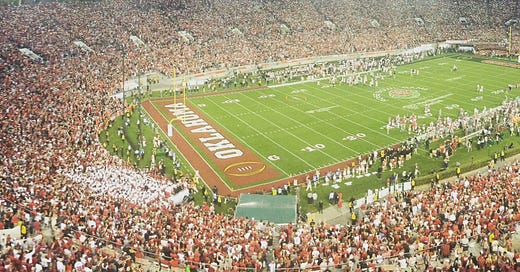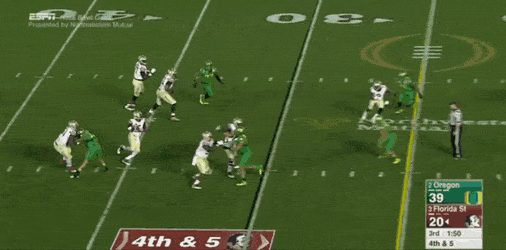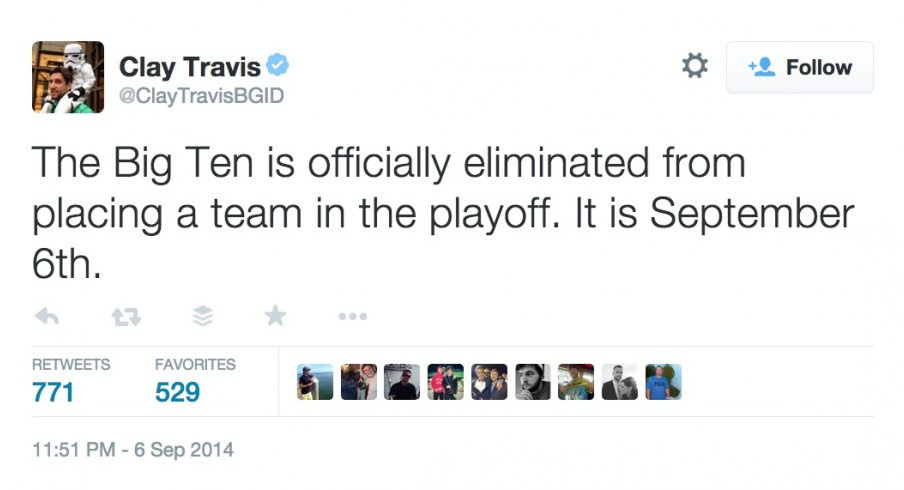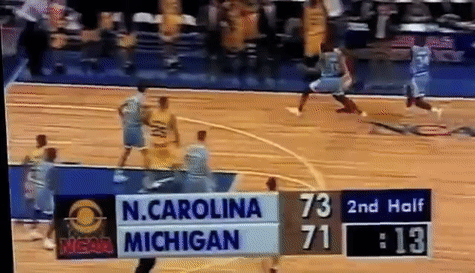Ranking Every College Football Playoff Semifinal
Most Playoff semifinals have been mismatched blowouts, but the few to deliver are college football classics.
Anyone who has followed this newsletter for any length of time knows I am not a fan of the College Football Playoff. The system flies in the face of college football tradition, despite tradition being a bedrock of the sport’s identity, and the Playoff feels like a Trojan horse for Fox and Disney executives to reshape the sport as a bastardized NFL Lite.
What’s more, Playoff games have been bad at a 2-to-1 margin since the format’s inception almost a decade ago.
But, with all that said, the 2022 Playoff semifinals delivered a pair of dramatic, entertaining games destined to live in college football lore for generations. A viewer experiencing the Playoff only in the vacuum of this year could see why so many fans clamored for this during the BCS era, and why TV decision-makers invest so heavily into the system.
With two instant classics in the books, I have taken it upon myself to rank every semifinal since the Playoff’s inception in 2014. Enjoy, and happy 2023.
Alabama vs. Michigan State, 2015 Cotton Bowl Classic
Choosing the four-team Playoff often comes down to a philosophical debate between most deserving or best-equipped to compete. I’m typically on the side of the former — I will argue until I’m blue in the face that UCF was more deserving of a bid in 2017 than Alabama, Penn State was more deserving than Ohio State the year prior, and regardless how the 2022 games went, TCU was the right choice over Alabama based on worthiness.
However, the 2015 season is one instance in which I could have sided with the latter philosophy.
Michigan State was more deserving of a Playoff bid than Stanford: Sparty lost only one game — to a sub-.500 Nebraska team in the Mike Riley era, but still, one loss all the same — and scored a head-to-head win over the Oregon team responsible for bouncing the Cardinal from Playoff contention.
But Christian McCaffrey-led Stanford absolutely would have put on better show in the Cotton Bowl than Michigan State, which looked like the most over-matched team in the brief history of the Playoff.
From a non-Alabama fan’s perspective, this abominable game is memorable solely for Nick Saban dancing like a velociraptor.
17. Clemson vs. Ohio State, 2016 Fiesta Bowl
“Deserving” and “best” are wholly subjective adjectives, though the former can be quantified more easily than the latter. And in the case of the 2016 season, my general sentiment that deserving should take precedent over a subjective determination of inviting the “best four teams” is that a committee’s determination of what’s the best can be embarrassingly off-the-mark.
Case in point, Clemson’s thorough deconstruction of Ohio State in the 2016 Fiesta Bowl.
The precedent that allowed Alabama to advance to the 2017 season’s Playoff was set a year earlier when an Ohio State team that failed to win not only its conference, but even its division, jumped Penn State for the final berth.
The Buckeyes didn’t take long to invalidate the Playoff committee’s decision to take an Ohio State team that lost head-to-head to Penn State, falling behind by three scores by halftime despite two takeaways.
By the time the ball dropped in Times Square, Ohio State became the first team shutout in the Fiesta Bowl since Arizona’s 29-0 rout of Miami in the game’s 1994 edition.
Saquon Barkley and Penn State, meanwhile, went haymaker-for-haymaker with USC in the best Rose Bowl Game since the Texas-USC classic in 2006. Spoiler alert, that distinction for the 2017 Granddaddy didn’t last long.
Clemson vs. Notre Dame, 2018 Cotton Bowl Classic
Notre Dame garners plenty of hate from the college football-watching nation, plenty of it justified. The Fighting Irish have been the beneficiaries of numerous advantages other programs are denied. But to contend Notre Dame hasn’t been a quality program since Brian Kelly took over and beyond is as delusional to the other extreme from the overzealous folks who awarded Tim Brown the Heisman or put the Irish in BCS bowls they didn’t earn.
At the same time, in Notre Dame’s resurgence from the collective failings of Bob Davie, Ty Willingham and Charlie Weis, the Fighting Irish have simply never been at the same tier as the heavyweights of the era. That was plainly evident in the 2018 Cotton Bowl when an undefeated Notre Dame team that beat some quality competition — a 10-win Stanford, a Michigan team that went to a New Year’s Six bowl — was immediately proven overmatched against Clemson.
This was the best all-around Clemson team of the late 2010s Tigers’ run of dominance, but the gap was still so lopsided, it underscored that in most years, there’s simply no need for a four-team Playoff.
Georgia vs. Michigan, 2021 Orange Bowl
There have been higher point differentials in the semifinals than Georgia’s 38-11 rout of Michigan a season ago, but this may have been the greatest disparity in all-around quality of opponents since Alabama-Michigan State in 2015.
Kirby Smart wisely let off the gas in preparation for a rematch with Alabama the following week, otherwise this could have been historically ugly. If nothing else, New Year’s revelers have to appreciate that this game was over well before halftime.
Alabama vs. Notre Dame, 2021 Rose Bowl Game (2020 season Playoff)
As noted with Notre Dame’s previous Playoff loss, the Fighting Irish earned their way into the Playoff — a win over Clemson gave Notre Dame an undeniable signature victory, and served as a highlight in the otherwise clouded pandemic season. But once there, the gap between Playoff-worthy and championship-contending was pronounced.
Notre Dame put up more of a fight than two years prior against Clemson, but eventually just wore down. Brian Kelly stayed in South Bend for another season, though his postgame comments functioned as the proverbial writing on the wall in a tacit admission that the gap between a school like Notre Dame and the SEC may be too wide to bridge.
I really don't want to continue to go down this path. We're going to keep getting here, okay? And we're going to keep banging at it and you guys watched the game, didn't you? They made plays on the perimeter. They made some dynamic plays.
They had the college football player of the year who made some dynamic plays. We battled. We were right there. So we're going to keep getting back here.
And I'm sorry if you don't like it or if the national media doesn't like it, but we're going to go back to work. We're going to keep recruiting and we're going to put ourselves back in this position again. And I think our kids battled and played really hard and physical. We ran the ball today.
And I'm not taking it personal, because these questions keep coming up like we have to reinvent ourselves. We were physical today. They were dynamic on the perimeter, like they have been all year. This is a really good football team. And we're just going to keep recruiting and keep playing and we're going to keep putting ourselves in this position. And that's all we can do.
Alabama vs. Clemson, 2018 Sugar Bowl (2017 season Playoff)
The Alabama-Clemson Playoff series from 2015 through 2018 is analogous to the Alien quadrilogy:
The introductory installment is a classic, one of the greatest entries into its genre with suspense and shocking twists throughout.
The sequel may actually surpass the quality of the original, culminating in a climatic finale for the ages.
Installment No. 4 isn’t good in any traditional sense, but was weird and unique and injected some humor into the series1.
And then, there’s No. 3. Alien 3 is a terrible movie that spent years in development hell, and once it finally saw light in 1992, lacked the suspense of the original and the action of the sequel.
Alien 3 is a dismal slog, a boring story with ugly, mustardy cinematography. I cannot imagine a more perfect metaphor for the 2018 Sugar Bowl.
Alabama vs. Washington, 2016 Peach Bowl
The peak of the Chris Petersen era at Washington petered out with all the flourish of a fawn constricted by an anaconda.
The Huskies’ outstanding defense played an outstanding game against Lane Kiffin’s ballyhooed Crimson Tide offense, but Washington’s inability to mount anything resembling a consistent attack on the other side of the ball doomed UW to the inevitable.
Unfortunately, the loss foreshadowed the remainder of Petersen’s time at Washington: stellar defense giving the Huskies ample opportunities to win games, but the offense simply not clicking enough to take the program to that next level.
Clemson vs. Oklahoma, 2015 Orange Bowl
I’m steadfast in my belief none of the above games can be ranked any higher than where I slotted them. I’ll entertain arguments to the contrary on this, which was technically a second-half comeback for Clemson.
Oklahoma led 17-16 at halftime when Baker Mayfield threw a touchdown just before the break, but that was it for Sooners offense the rest of the way. Clemson’s superiority became evident minutes into the third quarter, and the Tigers’ rolled to a three-touchdown blowout.
This wasn’t an especially good game, nor was it especially bad — competitive for a half is significantly better than much of the rest of the Playoff semifinals — but I dock it when compared to other semifinal blowouts for a key reason:
WHO THE HELL THOUGHT A DAYTIME KICKOFF WAS ACCEPTABLE IN THE ORANGE BOWL?
What a disgraceful affront to the tradition of the Orange Bowl as a nighttime game, dating back decades. Not since Ashlee Simpson drew the rancor of tens of thousands of drunk and angry Oklahoma fans in 2005 had the game’s organizers so clearly missed the mark.
Spit in the faces of Tom Osborne, Howard Schnellenberger, Charlie Ward and everyone else who built the OG Orange Bowl into one of the premier New Year’s events, why don’t you?
LSU vs. Oklahoma, 2019 Peach Bowl
Unlike the above Oklahoma semifinal loss, the 2019 Peach Bowl was never competitive. The Sooners functioned as nothing more than a speed bump on LSU’s road to the national championship, solidifying Ed Orgeron alongside Larry Coker as the most out-of-his-depth title-winning coach2 in my lifetime.
Coincidentally, like Coker’s 2001 Miami Hurricanes, the 2019 LSU Tigers didn’t need to play competitive games to be entertaining because they were just that damn talented.
One of the most prolific Heisman Trophy winners of all-time rolling up 63 points while throwing to maybe the most talented receiving corps ever assembled earns this blowout — the most lopsided in Oklahoma bowl history.
Alabama vs. Cincinnati, 2021 Cotton Bowl Classic
Cincinnati had to clear every conceivable hurdle the College Football Powers That Be threw in front of it in order to make the Playoff3. After doing so, the Bearcats were immediately dismissed as a fluke and treated in national media as a joke with no chance of winning the national championship.
And, like the multitude of semifinalists dispatched unceremoniously, Cincinnati just couldn’t keep up with heavyweight Alabama.
However, UC gave the Crimson Tide considerably more of a fight than Michigan State, Washington or Notre Dame in previous semifinals, and arguably more so than Clemson in 2016. To be within a manageable deficit going into the fourth quarter, 17-6, Cincinnati proved itself — and hopefully, future Group of Five challengers deserving of the opportunity — worthy.
What’s more, the story of Cincinnati’s College Football Playoff is less about the destination than the journey.
It’s not necessarily accurate to compare the Bearcats to the Saint Peter’s basketball team advancing to the Elite 8 of the NCAA Tournament just a few months later; the talent and resource disparities between a football program like Cincinnati’s measured against the upper-echelon of the Power Five is non-existent when compared to the gap between a conference like the MAAC and the power leagues of college basketball.
But a program like Saint Peter’s basketball at least gets a chance to compete in the arena of competition; outsiders of the College Football Playoff must navigate invisible barriers and reach always-moving goal posts. Cincinnati had to run the regular-season schedule twice, luck into its non-conference games (scheduled years prior) carrying weight with the committee, AND needed multiple power-conference champions to lose multiple games.
The Bearcats even reaching the 2021 Cotton Bowl is one of the most remarkable accomplishments in college football history, regardless the semifinal’s score.
Ohio State vs. Clemson, 2021 Sugar Bowl (2020 season Playoff)
Declaring the Clemson dynasty over is premature at best, and at worst reflective of the Ricky Bobby4 influence that too often plagues college football discourse. The Tigers just concluded an 11-win season with an ACC championship, and were very much alive for a Playoff berth in November.
Clemson’s decline, while slight, is undeniably real, though. The 2020 season marked the beginning of the dip, most evident in an Ohio State team that arguably shouldn’t have been in the field based on the merit of its resume absolutely stunting on the Tigers in the Sugar Bowl.
Clemson lost games from 2015 through 2019, sure — including a National Championship Game the season prior against LSU. But one year after outlasting Ohio State in a semifinal matchup for the record books, the Tigers looked outclassed in a way they hadn’t been even against LSU.
The Buckeyes ripping off 28 straight points in the first half was a barrage reminiscent not of Clemson teams in the previous four, or even previous six seasons5. I hadn't seen an opponent impose its will on a Tigers team in comparable fashion since West Virginia dumped 70 on Clemson in the 2012 Orange Bowl.
Alabama vs. Oklahoma, 2018 Orange Bowl
I initially ranked this game considerably lower; the outcome was never really in doubt thanks to an initial 28-0 Alabama onslaught. Anyone who remembers this game as a blowout can’t be blamed, even with the final 45-34 score. That’s the kind of the tally in the context of the first half that screams, “Garbage Time Touchdowns.”
That wasn’t the case, though. Oklahoma had pretty effectively kick-started its offense after an awful start, chipping away at the deficit down to 11 points by the third quarter. There’s an argument to be made that the Sooners actually outplayed the Crimson Tide for three of the Orange Bowl’s four quarters.
When you spot a team of Alabama’s caliber 21 points in the first quarter, however, the other three periods become irrelevant.
Oregon vs. Florida State, 2015 Rose Bowl Game (2014 season Playoff)
Try to recapture the mindset of 2014 before the Playoff debuted. What do you remember about that era?
If memories of Florida State fans as the most hostile beings on the planet spring to mind, congratulations: You were on the internet then.
Make no mistake: The Granddaddy of ‘Em All in January 2015 was an ass-kicking. Oregon was renowned for its speed and innovation on offense in this era, but the Ducks defense completely stifled the Seminoles offense in the first half, building a two-touchdown lead in the second quarter.
Florida State pulled within five by halftime, and again in the third quarter. It was a competitive game for more than two periods, but the wheels falling off the Seminoles seemed inevitable. And when they did, whew.
Oregon beat Florida State the same way it had just about every opponent that season, playing two quarters of competitive football before hitting the NOS and speeding away. However, in an anecdotal moment indicative of why I and countless others appreciate this blowout, I encountered a Seminoles homer who declared Florida State in control of the Rose Bowl before consecutive fumbles — the second of which became instant college football lore — despite Oregon leading by two touchdowns at that juncture in the game.
Again, if you were at all involved in the online football community in this era, you should recall how insufferable the Seminoles sub-sect of that community was at this time.
I personally have nothing against Florida State; I credit Charlie Ward for igniting my interest in college football and I’ve got love for Leonard Hamilton. The Florida State internet community of this era just happened to be the Gamergate of football fandom, so the Seminoles’ repeat hopes evaporating in a spectacular flameout — guaranteed to be remembered forever as the very first College Football Playoff game — was both cathartic and karmic.
Ohio State vs. Alabama, 2015 Sugar Bowl (2014 season Playoff)
Immediately following the memorable first Playoff semifinal came an encore that honestly made even a skeptic such as myself see the potential.
Ohio State had been written off as a Playoff hopeful before summer’s end. That’s no hyperbole, either. Here’s the sentiment of a perpetually wrong guy:
There’s even worthwhile debate to be had about the Buckeyes’ worthiness to be in the field, having leaped Baylor and TCU in the final rankings. Add Ohio State’s uncertainty at quarterback with top 5 Heisman finisher J.T. Barrett injured, and the Buckeyes were given little consideration playing Alabama in the SEC footprint.
All those conditions made for a Cinderella story of sorts.
As for the game itself, it’s the first in these rankings that could be considered a classic by any standard measure. Ezekiel Elliott’s 85-yard touchdown run is the stuff of legend.
TCU vs. Michigan, 2022 Fiesta Bowl
Confession time: I’m not fond of high-scoring football games when the offense is a byproduct of poor tackling or repeated blown coverage. West Virginia-Baylor 2012 is as ugly to me as Mississippi State-Auburn 2008.
Had this year’s Fiesta Bowl played out entirely like the third quarter, I’d have hated this game. Kudos to TCU and Michigan for executive offensively, but both defenses appeared completely disoriented and overmatched for those 15 minutes, save Dee Winters’ pick-six.
The Fiesta Bowl’s third quarter insanity was offset more than sufficiently with hard-hitting, clean tackles; savvy and dominant offensive line play; and gamesmanship for the other 45 minutes. It was just the right amount of caffeine to liven up what had previously felt like it was destined to be yet another semifinal blowout.
What’s more, TCU is the closest thing to a true Cinderella the Playoff has produced. Yes, Ohio State in 2014 was dismissed well before beating Alabama, but it’s Ohio State. With Urban Meyer coaching. That’s a program that’s born to be more Wicked Stepsister than Cinderella.
TCU spent the Bowl Championship Series years fighting for respect and attention in Conference USA and the Mountain West, never getting a shot at the national championship despite back-to-back perfect regular seasons.
Even as a member of the Big 12, the respect never truly seemed to come: Ohio State’s surprising title in the 2014 season came at the expense of the Horned Frogs’ Playoff invitation, after all, and this year, TCU was typically dismissed as more lucky than good, mocked as having no hope against real competition like Michigan.
The Frogs received the opportunity to prove it on the field, the concept on which the Playoff was pitched, and delivered in one of the 21st Century’s great games.
Clemson vs. Ohio State, 2019 Fiesta Bowl
Two future first-round NFL draft picks at quarterbacks, a host of other future pros on both sides of the ball, some controversy and a tidal wave of emotion: The 2019 Fiesta Bowl provided everything a spectator could want from a championship-level contest.
Trevor Lawrence’s go-ahead touchdown pass to Travis Etienne and subsequent two-point conversion was a sequence that, perhaps more than any other, encapsulates the quarterback’s greatness in college.
However, the 2019 Fiesta Bowl is arguably better known for the subsequent Ohio State possession.
Justin Fields was absolutely cooking with four straight completions and two runs, one of which converted a first down on third-and-1. His drive will forever be remembered instead for the miscommunication that resulted in Clemson’s win-sealing interception.
It’s a harsh reality of sports under the brightest lights. Were you to poll 100 basketball fans on their first association between Chris Webber and the national championship, I’d put responses conservatively at 98 percent they mention the timeout he called to draw a technical foul — not that he finished with 23 points, 11 rebounds and three blocked shots.
Georgia vs. Ohio State, 2022 Peach Bowl
Honestly, any Ohio State fans reading this, I swear I am not intentionally sprinkling salt in your wounds. Alas, your Buckeyes have fallen on the losing side of two of the greatest college football games of my lifetime.
After TCU and Michigan delivered the goods, ESPN rolled over into coverage of the Peach Bowl and I resigned myself to a bad game. Juvenile as it is, I had experienced enough Playoffs to know that one great game guaranteed us a stinker to follow.
I’m glad to be proven wrong.
Georgia’s fourth-quarter comeback, culminating in a go-ahead score with a minute remaining and its win sealed with a missed field goal as the calendar flipped to 2023 in the Eastern Time Zone, provided the perfect finish to a remarkable bowl game.

Georgia vs. Oklahoma, 2018 Rose Bowl Game (2017 season Playoff)
A comeback, overtime, individual performances that rank among the best in the century-plus history of the first and greatest of all the bowls: The 2018 Rose Bowl Game stands as one of the best matchups ever in college football, let alone the Playoff era.
I had the privilege of covering this game, and it’s easily the No. 1 contest I’ve been in the venue for live. Sony Michel and Nick Chubb’s combined efforts, including the former going 27 yards for the game-winning touchdown, were downright awe-inspiring.
What’s more, this (along with the Texas-USC BCS Championship Game) was the quintessential example of why the Rose Bowl needs to remain a fixture of the postseason even as the sport evolves its postseason.
The postgame homage to Suge Knight’s Source Awards acceptance speech was funny both for its intended purposes, and the parallels between Dabo Swinney and Suge as leaders of their respective brands who didn’t want to see their talent get paid.
I can practically hear some of you saying “Gene Chizik,” and no. Absolutely not. Yes, Auburn regressed badly once Chizik was no longer operating through the conduit of Cam Newton, having arguably the single-greatest season from a quarterback ever, but Chizik also coordinated a North Carolina defense that nearly won the ACC in 2015, after his time at Auburn. Coker coordinated the Barry Sanders-era Oklahoma State offense, but the game passed him by with the arrival of the 21st Century. Orgeron is a great recruiter and respected positions coach, but depicted as something more by insider media who appreciate his candor and the worst kind of football fans who like his accent.
This is actually a topic I spent a year cataloging for a feature story, which I meant to publish last offseason. Truth is, it’s such a big-swing piece that I had to put it on the backburner but plan to revisit this offseason (along with a look at the 10-year anniversary of the death of the BIG EAST.
“If you ain’t first, yer last!”
The 2013 Tigers are underappreciated in their importance to transforming the energy around Clemson football. Tahj Boyd — one of the best quarterbacks of the 2010s relative to how often his name comes up — led the Tigers to a redemptive Orange Bowl win over none other than Ohio State, a game that landed Clemson at No. 8 in the final AP Top 25 and marked an unofficial origin point for the Dabo Dynasty.







